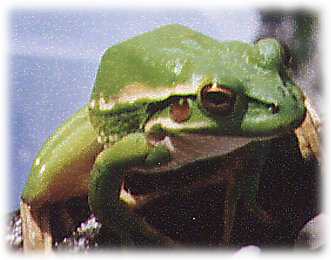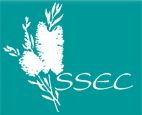Green & Golden Bell Treefrog |

One of the Peninsula's Green and Golden Bell Frogs
Photo: Annette Hogan |
Despite the fact that sandmining on the Kurnell Peninsula has effectively demolished the once mighty sand dunes, in the process the huge lakes that have now replaced the dunes have provided habitat for the endangered Green and Golden Bell Frog. The present population is probably representative of a much larger population which existed in freshwater ponds around Botany Bay.
The frogs are known to occur on many parts of the Peninsula including the H6 Australand site, Kurnell landfill sites, the Cronulla Sewage Treatment Plant, Botany Bay National Park and Towra Point Nature Reserve. It has been suggested that the population could indeed be more significant than the 400 adults observed at Homebush Bay and may be the largest in NSW. A comprehensive Peninsula-wide survey has been somewhat difficult given the extent of private land on the Peninsula. |

Photo: Annette Hogan |
A limited survey of frogs was undertaken in 1996 during the Environmental Impact Assessment process for the upgrade of the Cronulla Sewage Treatment Plant. It found that over a 19 day period, sixty frogs, both juvenile and mature, were observed in a variety of locations on the STP site. Many were observed on the boundaries on the overflow pond "Keegans Lake". During the upgrade of the STP in 1999-2001, it was decided that Keegans Lake would be capped to contain the spread of invasive weeds. In the process, existing habitat found to be used by the Green and Golden Bell Frog was compromised. This was the subject of much debate by community and environment interests. The 1996 survey indicated that the Lake was not being used as a breeding site but as an area where (juvenile) frogs rested over winter, fed and found access to other areas. The survey recommended that additional breeding ponds be established to aid breeding of the frogs on the site. This was incorporated and ponds were constructed during the upgrade in 2000. Frogs were released into these ponds in December 2000. After capping, Keegans Lake was re-planted to create a frog foraging area.
Loss of habitat is one of many threats to the Green and Golden Bell Frog population on the Peninsula. Much of the habitat occurs outside the Peninsula's prescribed fauna conservation areas and is under threat from development. In the Kurnell landfill site many of the lakes used by the frogs are being filled thereby forcing the frogs to move elsewhere. Residential development proposals for the Australand site will also involve filling of ponds where frogs have been observed. |

One of the many ponds that provide frog habitat.
Photo: Daphne Salt |
| The frogs are also under threat from the introduced Mosquito Fish (Gambusia) which occurs in many ponds on the Peninsula. The Gambusia 'feast' on the frog eggs and tadpoles thereby putting further pressure on the population. |
| top of page |



